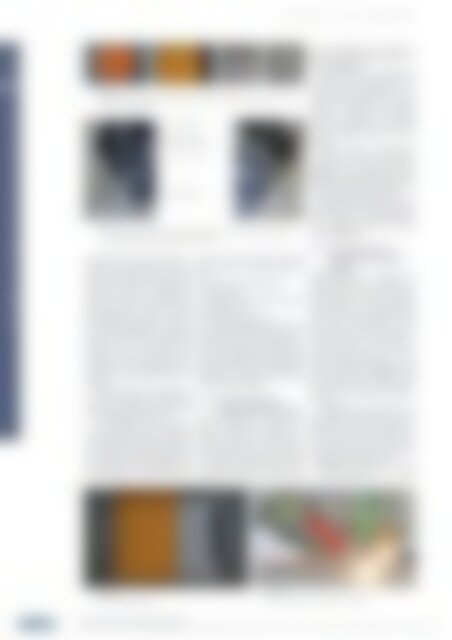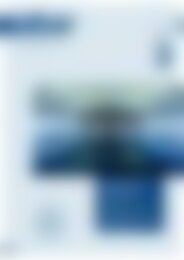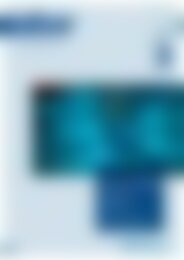atw - International Journal for Nuclear Power | 11/12.2019
Ever since its first issue in 1956, the atw – International Journal for Nuclear Power has been a publisher of specialist articles, background reports, interviews and news about developments and trends from all important sectors of nuclear energy, nuclear technology and the energy industry. Internationally current and competent, the professional journal atw is a valuable source of information. www.nucmag.com
Ever since its first issue in 1956, the atw – International Journal for Nuclear Power has been a publisher of specialist articles, background reports, interviews and news about developments and trends from all important sectors of nuclear energy, nuclear technology and the energy industry. Internationally current and competent, the professional journal atw is a valuable source of information.
www.nucmag.com
Create successful ePaper yourself
Turn your PDF publications into a flip-book with our unique Google optimized e-Paper software.
<strong>atw</strong> Vol. 64 (2019) | Issue <strong>11</strong>/12 ı November/December<br />
DECOMMISSIONING AND WASTE MANAGEMENT 546<br />
| Fig. 6.<br />
Overview of tested samples as supplied by KTE (A– lid of a 200 liter drum, B– steel sheet, C– coated u<br />
profile, D– locker door part).<br />
| Fig. 7.<br />
Components <strong>for</strong> decontamination of complex metal surfaces, (A) laser tool <strong>for</strong> the decoating of flat<br />
surfaces and (B) laser tool <strong>for</strong> the decontamination of edges.<br />
transported using optical fibres to<br />
reach the experimental area. This<br />
feature allows <strong>for</strong> the protection of<br />
costly laser equipment from contamination<br />
in any case, as described in<br />
section 2. The user can simply equip<br />
the required laser tool and start the<br />
decontamination process. Suction<br />
and filtration of mobilized contamination<br />
at high efficiency is facilitated<br />
applying a commercial filtration and<br />
suction unit by ULT GmbH. The<br />
localized suction of aerosols leads to<br />
prevention of recontamination and<br />
guarantees clear vision <strong>for</strong> the user at<br />
all times.<br />
Restricted access to the experimental<br />
area is beneficial to simplify the<br />
laser safety requirements, even in case<br />
of a technology demonstration.<br />
A full-fledged risk assessment<br />
according to §5 of ArbSchG [18] and<br />
§3 of ArbStättV [19] has been filed to<br />
scan <strong>for</strong> any arising risks <strong>for</strong> operators<br />
coming along with the application of<br />
the whole set up. All requirements of<br />
the occupational safety have been<br />
tested and proven. The risk assessment<br />
covers the following subject<br />
area:<br />
p General occupational safety<br />
p Laser safety<br />
p Safety from toxic substances (PCB)<br />
p Radiation safety<br />
p Respiratory protection<br />
The risk assessment complies with the<br />
laws, guidelines (ASR), workers compensation<br />
board rules and provisions.<br />
The risk assessment was finalized by<br />
TU Dresden and IABG and checked by<br />
KTE and has been the fundamental<br />
milestone <strong>for</strong> approval of the on-site<br />
demonstration at MZFR.<br />
5.3 Decontamination of<br />
complex metal geometries<br />
The decontamination of metal surfaces<br />
at MZFR was conducted on<br />
paints and metals prior unknown, to<br />
check the ability to transfer results<br />
from laboratory scale to on-site tests.<br />
To test limits of the laser tool, samples<br />
of varying geometries have been<br />
supplied by KTE, e.g. painted steel<br />
sheets, bracket steel or complex surfaces<br />
like ridges/spline/serration, as<br />
shown in Figure 6.<br />
Different laser tools were designed<br />
to ensure the decontamination at<br />
different surface geometries, e.g. in<br />
case of tighter angles the tool was<br />
adapted to maintain the complete<br />
suction of particles and aerosols<br />
during the laser process. A tool change<br />
can be completed within 1.5 min,<br />
Figure 7.<br />
Similar ablation characteristics<br />
were found <strong>for</strong> all tested samples as<br />
compared to the laboratory results<br />
(Figure 2). This implies that generalized<br />
material characteristics <strong>for</strong> paint<br />
layers and metals can be applied.<br />
From practical point of view, the<br />
flexibility of the laser ablation process<br />
was verified, as all tested geometries<br />
were completely cleaned without<br />
residues (Figure 8).<br />
5.4 Decontamination of<br />
concrete walls and floor<br />
at MZFR<br />
Decontamination of concrete demands<br />
solutions <strong>for</strong> a multitude of<br />
demands, e.g. uneven surfaces, varying<br />
thicknesses of paint, different<br />
shapes of surfaces and unknown PCB<br />
concentration in the decontamination<br />
paint. The practicability of the<br />
developed laser system was tested on<br />
walls and floors at the MZFR on<br />
sample surfaces sized 30 x 30 cm².<br />
The decontamination paint on the<br />
wall was thin and exhibited a high<br />
PCB concen tration (see Table 3). The<br />
floor featured lower PCB concentration<br />
and very thick paint (approx.<br />
1.5 mm).<br />
In Figure 9 the side view of the<br />
laser head is shown during the decontamination.<br />
During the process all<br />
arising by-products, like visible particles<br />
and gases, are extracted by the<br />
extraction and filtration unit and do<br />
not endanger the working staff.<br />
Figure 10 displays the result<br />
of decontamination on a floor<br />
| Fig. 8.<br />
Steel sheet partly decoated.<br />
| Fig. 9.<br />
Laser head during the decontamination of the floor.<br />
Decommissioning and Waste Management<br />
First On-site Demonstration of Laser- based Decontamination Technology in Germany ı Torsten Kahl, Georg Greifzu, Carsten Friedrich, Christian Held, Marion Herrmann, Wolfgang Lippmann and Antonio Hurtado

















